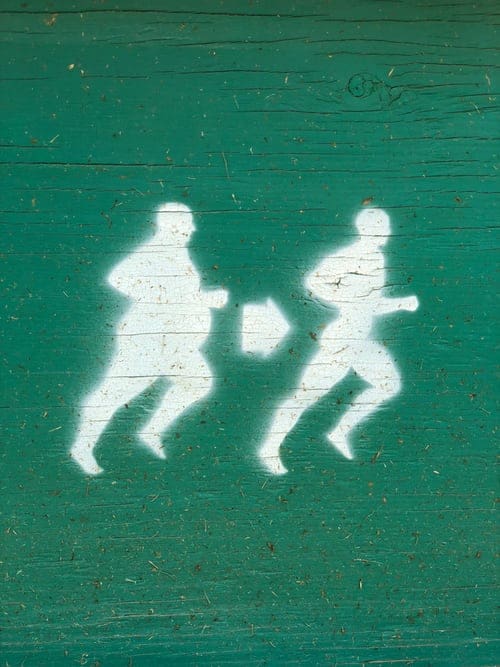Were You The Fastest Kid in the Neighborhood?
Growing up, we were all challenged to a foot race at some point, to see who was faster.
In sports, sprinting was always a part of conditioning, and your speed sometimes determined what position you would play.
Lose weight and get healthy with SPRINTS.
As we got older, the peer competition in athletics seemed to fade, so we found other ways to compete that were more sedentary.
Most people would never dream of doing sprints at the age of 50, because who are you going to race against?
Well, this is actually about Sprint workouts that make you more fit and help you lose weight.
Have you ever noticed the body type difference between a sprinter and a distance runner?
The sprinter is usually more muscular and looks to be in better shape.
If you want to get into shape quicker, you need to add sprinting to your exercise program.
Let’s take a look at an anaerobic exercise program called “Sprint 8”, conceived by Phil Campbell.
I was first introduced to Sprint 8 about 10 years ago when a friend gave me the book “Ready, Set, Go! Synergy Fitness for Time Crunched Adults”, by Phil Campbell.
I had already done some of the principles years earlier when I got on the “Body For Life” program, but I just didn’t realize it.
Sprinting is another form of High Intensity Interval Training or HIIT.
Always check with your Doctor before starting a new exercise program…we ain’t what we used to be!

Fast Twitch Muscle Fibers
Sprinting is a great way to get your Type II or “Fast Twitch” muscle fibers stimulated.
Our skeletal muscle system is comprised of Type I and Type II muscle fibers.
Type I or “Slow Twitch” muscle fibers are the ones that keep our bodies going along as normal, such as walking or jogging.
Type II fibers will kick in when the Type I fibers need help, for instance when a short burst of speed is needed.
As we age, our fast twitch muscle fibers are not being utilized as much, so they can atrophy over time.
Sprinting is a good way to get them firing again, so you don’t lose muscle mass as quickly.
Benefits
Human Growth Hormone (HGH) is released when Sprint 8 is done correctly.
Bone density and muscle mass rely on HGH whether it is produced naturally or injected.
Somatopause is a medical term that means the loss of Human Growth Hormone (HGH), that will eventually result in wrinkled skin, and lack of energy as we age.
Anaerobic exercise increases our HGH levels, which may replace some of those things we lose with age.
So, it’s probably safe to say that Sprint exercising reverses some of the effects of somatopause.
EPOC – Excess Post-Exercise Oxygen Consumption
EPOC is a positive effect that burns more calories long after a workout is finished.
If you exercise and your body heats up, it naturally wants to cool down to normal temperatures.
Any exercise that eats up more oxygen than normal, will burn more calories trying to get back to homeostasis, which is your body’s natural state of being.
The intensity of the workout has shown to be more important than the duration when burning more calories, because you are using more oxygen.
The fast twitch muscle fibers burn glycogen which are actually carbohydrates that are stored in the muscle cells for energy.
These energy stores are depleted quickly when you are engaged in sprinting or any other HIIT style exercise.
This in turn, will make your body burn more calories.

Sprint 8 Work Out
Sprint 8 has you doing a sprint work out 3 times a week.
The sprint only lasts 30 seconds at a time and you’ll be doing 8 sprints per workout. Sound easy?
It’s not.
It’s specifically designed for all of us and the changes we face after the age of 30.
I am reaching out to men over 50 because I know how it feels when we reach that milestone.
Sprint 8 is a great training program to incorporate into your existing schedule or if you are starting out fresh.
The workout will have you do a warmup, a 30 second sprint, then 1.5 minutes of active rest or just walking back to your starting point.
If you do this 3 times a week, that’s 20 minutes a week of Sprint 8. If you can’t start out with the full workout, that’s OK.
Start with what you can do then increase from there. You can start the Sprint 8 at whatever fitness level you are in at the time.
The intensity is scalable, so it’s up to you to get started.
Please check with your medical professional before starting any exercise program.
Just get Started!
If you aren’t at the level of performing 8 sprints when you begin, that can be a good thing.
Make it a goal to get to 8 sprints per workout. Most people who don’t have a goal to work towards, never really have a reason to get better.
Your goal is also measurable which will give you sense of accomplishment.
If you can’t sprint for 30 seconds, try 10 or 15 seconds. Or go for 50 yards, turn around and walk back. It’s all up to you.
The Sprint 8 website has an explanation also on how to get started, but the book lays it out for you.
When I started doing Sprint 8, I only did about 6 to 8 sprints for 80 yards.
This was pretty tough for me, since I had not been doing any running for a while before that.
I also only did it 2 days a week. It still worked for me though, so my suggestion is to just get started.
Mayo Clinic
If you have musculoskeletal problems Mayo Clinic recommends options that include elliptical machines, bicycling, or water running which will still challenge you without hammering your joints.
Edward R. Laskowski, MD. co-director of Mayo Clinic Sports Medicine Center, states that
“There’s solid evidence that older, less active, overweight and obese individuals can benefit from HIIT training,” explains Dr. Laskowski. “HIIT has also been shown to be very safe and effective in patients with heart disease and type 2 diabetes. In all of these populations, HIIT programs can produce significant benefit for the cardiovascular system and improved metabolic parameters. And people seem to like it better than traditional endurance exercise.”
Check out HIIT for other short burst exercises.
Practice What You Preach
So, I’m sitting here telling you about how you need to get going on this Sprint 8 program.
I haven’t done it all winter, because I started working out at home and got out of the habit of sprinting.
Before that, I was working out at the Marshall University Rec Center which has an indoor track and it was easy to do my sprints there.
When I transitioned to home workouts, I just forgot about the running part.
I am on my way back though, going to the park and starting back gradually with a fast jog instead of an all out sprint.
I want to make sure my knees are ready for it, before I take off with blinding speed.
Conclusion
At the end of the day, you can transform your body with sprints, whether running, cycling, swimming…it doesn’t matter.
A set of Mountain Climbers done quickly for 20 seconds counts as a sprint also.
You’re getting your heart rate up and building muscle, losing fat, all at the same time.
And you can do this at any age as long as your joints are healthy.
Older men need to start out slow and move forward progressively.
I recommend you at least get the book Ready, Set, Go!, by Phil Campbell.
They also have the system incorporated into equipment if you want to buy it.
And by the way, I was NOT the fastest kid in the neighborhood.
SOURCES
https://www.webmd.com/diet/a-z/body-for-life
https://www.healthline.com/health/sprinting-workouts#next-level-workouts
https://www.mylifeline.org/living/updates/post/1540180
https://www.precor.com/en/resources/coaching-centre/afterburn-effect-understanding-science-epoc
